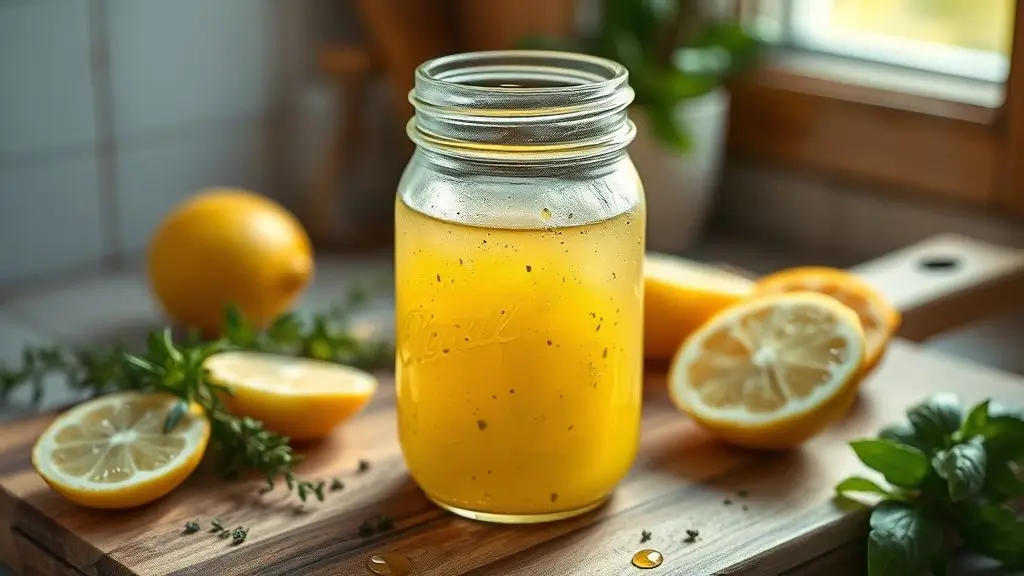Picture this: you’re staring at a gorgeous pile of fresh greens, and suddenly you realize your salad drawer is stocked with nothing but those sad, sugar-laden store-bought dressings. Sound familiar? Trust me, I’ve been there more times than I care to admit. But here’s the thing – making your own lemon vinaigrette is so ridiculously simple that once you try it, you’ll wonder why you ever bothered with those expensive bottles.
I discovered this game-changing recipe during a particularly hectic week when I had zero time for grocery shopping but desperately needed something to jazz up my wilted lettuce situation. What started as a desperate kitchen experiment became my absolute favorite go-to dressing, and honestly, it’s saved my salad game more times than I can count.
Table of Contents :
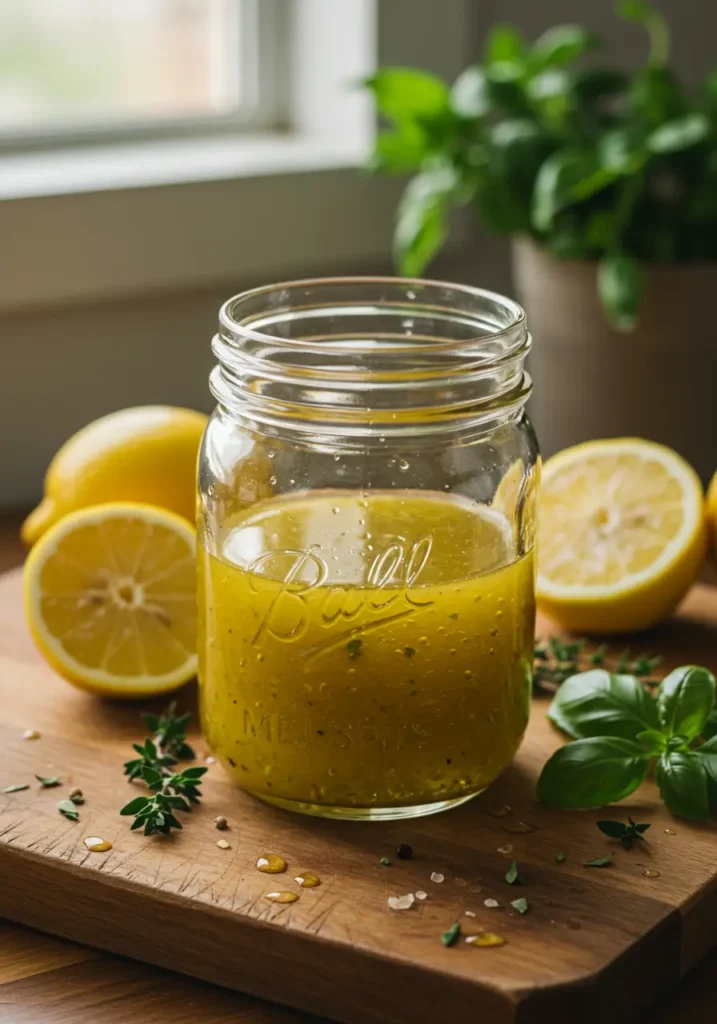
Why This Lemon Vinaigrette Recipe Beats Everything Else
Let’s be real here – most homemade vinaigrette recipes either taste like straight vinegar or end up being so bland they make cardboard seem flavorful. This recipe hits that perfect sweet spot where every ingredient actually contributes something meaningful to the party.
What makes this version special:
- Perfect acid balance – no puckering faces here
- Emulsifies beautifully – stays mixed instead of separating immediately
- Versatile flavor profile – works on literally everything
- Takes under 5 minutes – because who has time for complicated dressings?
The secret weapon? A tiny bit of Dijon mustard that acts as both an emulsifier and flavor enhancer. It’s like having a culinary chemistry degree without actually needing one.
The Science Behind Perfect Lemon Vinaigrette
Okay, before your eyes glaze over thinking I’m about to get all nerdy on you – stick with me for just a minute. Understanding why this recipe works will help you nail it every single time.
The Golden Ratio Theory
Most vinaigrettes follow a 3:1 oil-to-acid ratio, but honestly? That’s often too harsh for lemon-based dressings. Fresh lemon juice is more acidic than most vinegars, so we’re going with a gentler 4:1 ratio that lets the lemon shine without overwhelming your taste buds.
Emulsification Magic
Here’s where that Dijon mustard earns its keep. Mustard contains natural emulsifiers that help oil and water-based ingredients play nice together. Without it, you’d be shaking your dressing every single time you use it – and let’s face it, nobody has patience for that.
The Best Lemon Vinaigrette Recipe
Prep Time: 5 minutes
Total Time: 5 minutes
Servings: About 1/2 cup (enough for 4-6 salads)
Ingredients You’ll Actually Want to Use
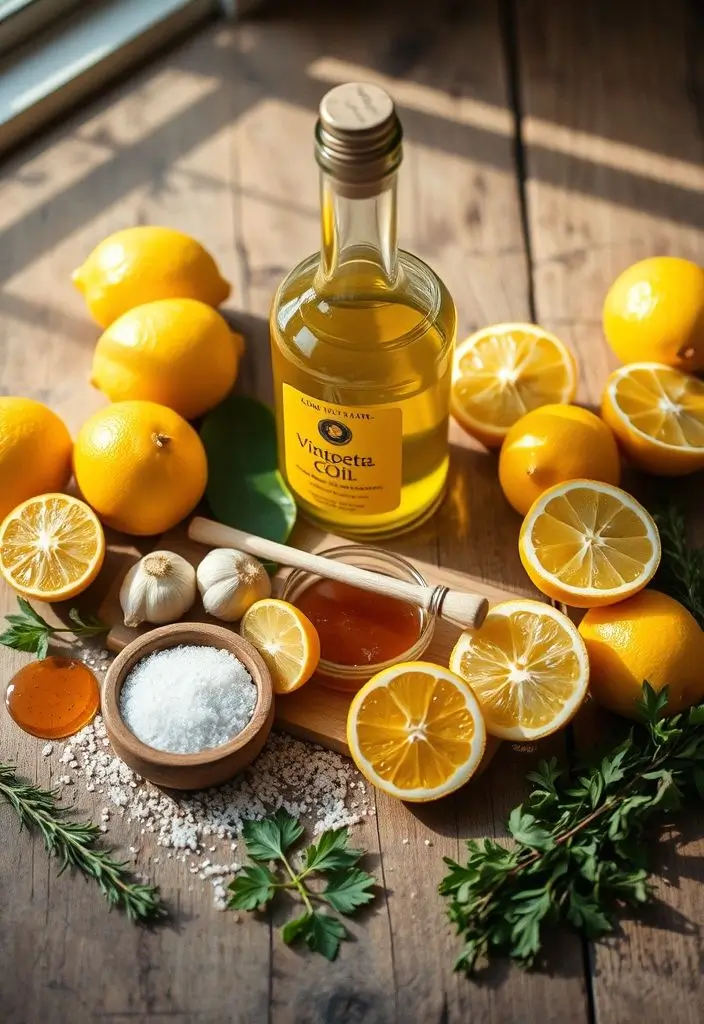
- 1/4 cup fresh lemon juice (about 2 large lemons)
- 1/2 cup extra virgin olive oil
- 1 teaspoon Dijon mustard
- 1 clove garlic, minced (or 1/2 teaspoon garlic powder if you’re feeling lazy)
- 1 teaspoon honey (maple syrup works too for my vegan friends)
- 1/2 teaspoon salt
- 1/4 teaspoon black pepper
- 1 tablespoon fresh herbs (optional but highly recommended)
Step-by-Step Instructions That Actually Work
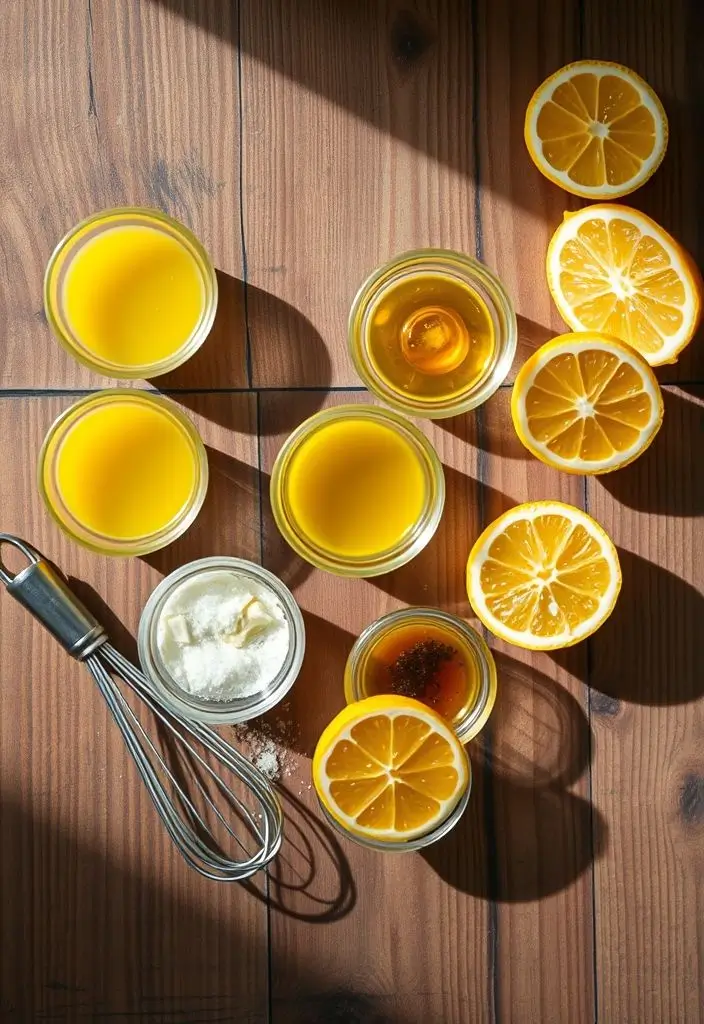
Step 1: Prep Your Lemon Like a Pro Roll your lemons on the counter while pressing down firmly – this breaks down the internal membranes and makes juicing way easier. Trust me on this one; I learned it from my Italian grandmother, and that woman knew her way around citrus.
Step 2: Build Your Base In a medium bowl, whisk together the lemon juice, Dijon mustard, minced garlic, honey, salt, and pepper. This creates your flavor foundation – taste it now and adjust the salt if needed.
Step 3: The Slow Pour Technique Here’s where most people mess up. Instead of dumping all the oil in at once, drizzle it in slowly while whisking constantly. Start with just a few drops, then gradually increase to a thin stream. This gradual process creates that creamy, stable emulsion we’re after.
Step 4: The Final Touch Once all the oil is incorporated, add your fresh herbs if using. I’m partial to fresh thyme or oregano, but basil, parsley, or even a bit of fresh dill work beautifully.
Pro Tips That’ll Make You Look Like a Kitchen Wizard
Temperature Matters More Than You Think
Room temperature ingredients emulsify better than cold ones. If your olive oil has been chilling in a cool pantry, let it come to room temp for about 10 minutes before using. Cold oil is stubborn and won’t play nice with the other ingredients.
The Mason Jar Shortcut
Feeling too lazy to whisk? (No judgment here – we’ve all been there.) Throw everything into a mason jar, screw on the lid, and shake like your life depends on it for about 30 seconds. It works surprisingly well, though you won’t get quite the same silky texture as proper whisking.
Fresh vs. Bottled Lemon Juice Debate
I’m gonna be straight with you – fresh lemon juice makes a noticeable difference. Those plastic lemon-shaped bottles taste flat and artificial compared to the bright, vibrant flavor of fresh lemons. That said, if bottled is what you’ve got, it’ll still make a decent dressing. Just maybe add an extra squeeze of fresh lemon zest to perk things up.
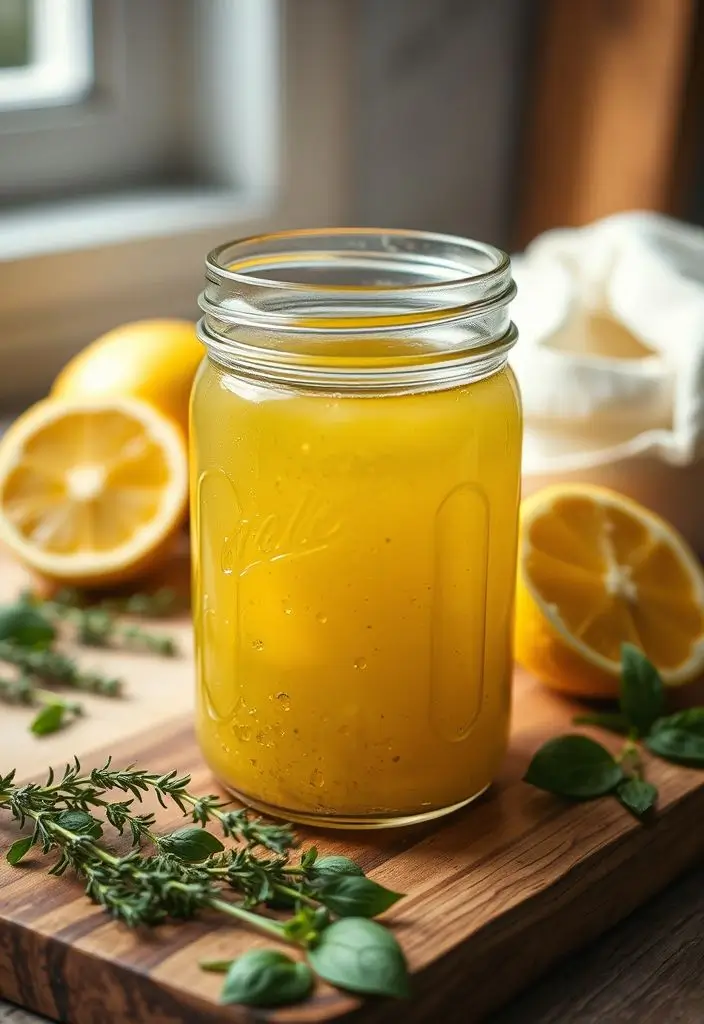
Customization Options That’ll Blow Your Mind
Herb Variations That Never Disappoint
- Mediterranean blend: Fresh oregano, basil, and a pinch of dried rosemary
- French countryside: Fresh thyme and tarragon
- Garden fresh: Parsley, chives, and a bit of fresh dill
- Spicy kick: Add a pinch of red pepper flakes or a dash of hot sauce
Sweet and Savory Twists
For a sweeter profile: Replace honey with maple syrup or agave, and add a tiny pinch of vanilla extract (sounds weird, tastes amazing).
For umami depth: Add a teaspoon of capers or a small anchovy fillet mashed into the garlic.
For Asian-inspired flavors: Swap half the lemon juice for rice vinegar and add a touch of sesame oil.
Storage and Shelf Life Reality Check
How Long Does Homemade Vinaigrette Actually Last?
In the fridge, this beauty will keep for about a week in a sealed container. The flavors actually improve after a day or two as everything melds together – kind of like how leftover pizza somehow tastes better the next morning.
Storage Pro Tips
- Use a glass jar or container – plastic can absorb flavors and make your dressing taste weird
- Label with the date – trust me, you’ll forget when you made it
- Give it a good shake before each use since natural separation is totally normal
What to Serve This Lemon Vinaigrette With
Salad Combinations That Actually Taste Good Together
Classic Green Salad: Mixed greens, cucumber, cherry tomatoes, and red onion – simple but never boring.
Mediterranean Power Bowl: Spinach, chickpeas, feta cheese, olives, and roasted red peppers.
Summer Stone Fruit Salad: Arugula, sliced peaches or nectarines, goat cheese, and toasted pine nuts.
Beyond Salads: Creative Uses You Haven’t Thought Of
This vinaigrette isn’t just for lettuce, FYI. I’ve used it as:
- Marinade for grilled chicken or fish (30 minutes is plenty)
- Drizzle over roasted vegetables (especially asparagus and Brussels sprouts)
- Dip for fresh bread (very European of me, I know)
- Light sauce for grain bowls (quinoa + roasted veggies + this dressing = perfection)
Nutritional Benefits That Don’t Suck
Why Homemade Beats Store-Bought Every Time
Most commercial dressings are loaded with preservatives, artificial flavors, and enough sugar to make your dentist weep. This homemade version gives you:
- Healthy fats from olive oil that actually help your body absorb fat-soluble vitamins
- Vitamin C from fresh lemon juice for immune system support
- No artificial preservatives or weird chemicals you can’t pronounce
- Control over sodium content – you decide how much salt goes in
Common Mistakes and How to Avoid Them
The Separation Situation
If your vinaigrette breaks and looks like an oily mess, don’t panic. Start with a fresh teaspoon of Dijon mustard in a clean bowl, then slowly whisk your broken dressing back into it. It’s like relationship counseling for oil and vinegar.
Over-Seasoning Disasters
Taste as you go, especially with the salt. It’s way easier to add more than to fix an over-salted dressing. If you do go overboard, add a bit more lemon juice and oil to balance things out.
The Garlic Overload Problem
Fresh garlic gets stronger the longer it sits in acidic dressing. If you’re meal prepping, start with less garlic than you think you need, or consider using garlic powder for a milder, more stable flavor.
Seasonal Variations to Keep Things Interesting
Spring Fresh
Add fresh mint and a touch of lemon zest for a bright, awakening flavor that pairs perfectly with early spring greens and peas.
Summer Abundance
Incorporate fresh basil and a tiny bit of balsamic vinegar for depth. Perfect with tomatoes, mozzarella, and stone fruits.
Fall Comfort
Try adding a pinch of Dijon mustard and some fresh sage. Works beautifully with heartier greens like kale and roasted root vegetables.
Winter Warmth
Add a touch of orange zest along with the lemon, plus some fresh thyme. Brightens up those heavy winter salads when you’re desperately craving something fresh.
The Bottom Line: Why This Recipe Actually Matters
Look, I know we’re just talking about salad dressing here, but honestly? Having a go-to vinaigrette recipe that you can whip up without thinking about it is genuinely life-changing. It’s one of those small kitchen skills that makes you feel like you’ve got your act together, even when the rest of your life might be a beautiful disaster.
This lemon vinaigrette has become my kitchen security blanket – the thing I make when I want something fresh and delicious without any fuss. It’s pulled me out of countless “what am I going to eat?” moments and made even the saddest bag of pre-washed lettuce taste like something special.
So next time you’re standing in the salad dressing aisle, wondering if you really need to spend six bucks on a tiny bottle of something with 47 ingredients you can’t pronounce, remember this recipe. Your taste buds (and your wallet) will thank you. Plus, you’ll get to feel slightly superior when your friends ask what makes your salads taste so much better than theirs 🙂
Give it a try, and let me know what you think. IMO, once you go homemade with vinaigrettes, there’s really no going back to the store-bought stuff.

